Are your learners mixing up b and d? Try one of these tricks to end b d confusion!
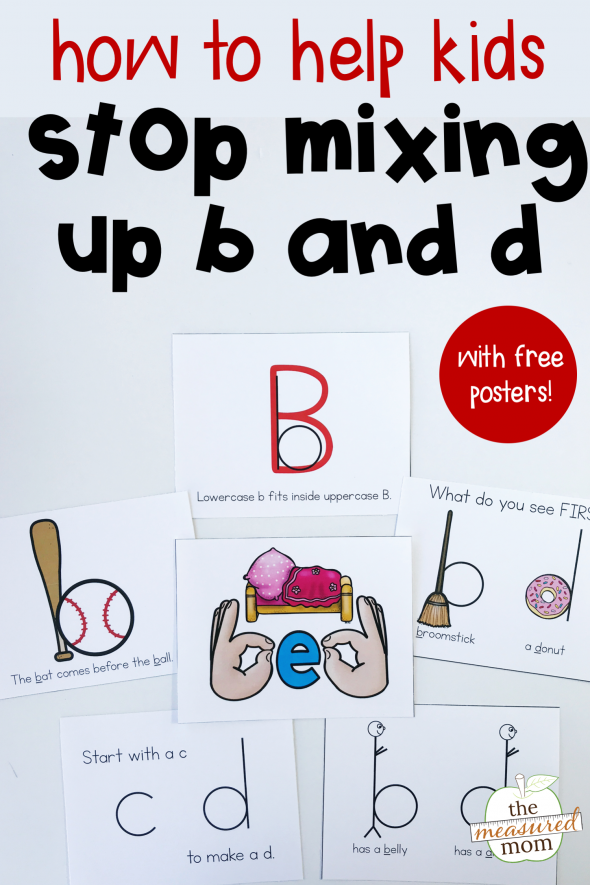
I recently shared a newsletter with tips for helping kids with b and d letter reversals. Many of my readers e-mailed back with even more ideas.
I’ve put them together in this blog post. Use these ideas to clear up that b d confusion!
Then grab the free posters in the download at the end of the post.
How to help kids stop mixing up b and d
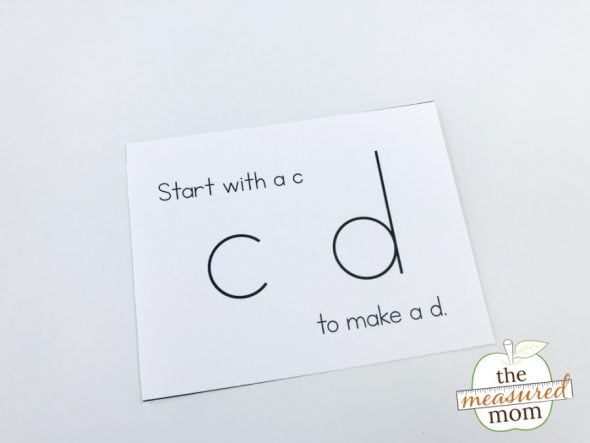
1 – Teach your students that you write c before you make the d.
Show them that they start out making a c, which turns into a d. Your cue could be “c the d” or “start with a c to make a d.”
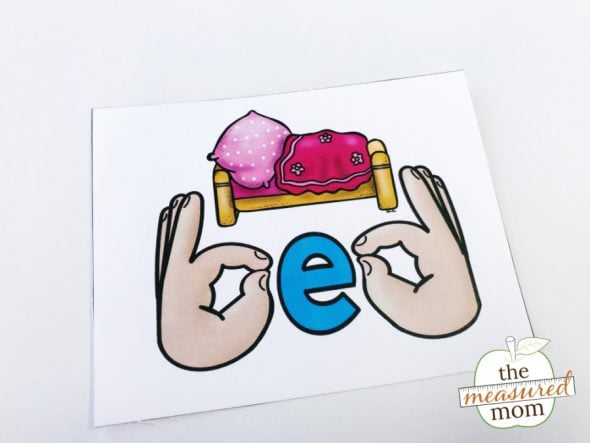
2 – A classic trick is to show kids how to make a bed with their hands.
The b comes first, and the d comes second, just as in the letters of the word bed.
3 – Some people find it helpful to over-teach whatever letter the child can form with the non-dominant hand.
For example, if a child is right-handed, s/he can form a b with the fingers of the left hand. If the child is left-handed, s/he will always hold up the right hand to make a d. This is an easy, quick way for kids to check when they’re reading and writing.
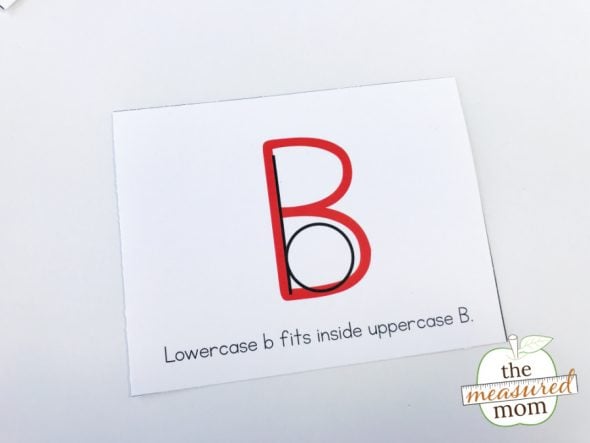
4 – Teach your learners that little b fits right inside uppercase B.
5 – Some educators like to focus on where the letters form in the mouth.
You can teach your learners that when say b, their lips begin with a straight line, just as the letter b does. But when you say the letter d, your lips are open; this resembles the circle at the start of the letter d.
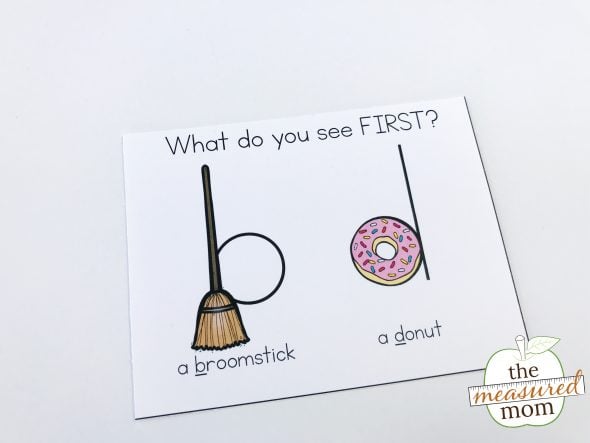
6 – When looking at b and d, what do you see first? A broomstick or a donut?
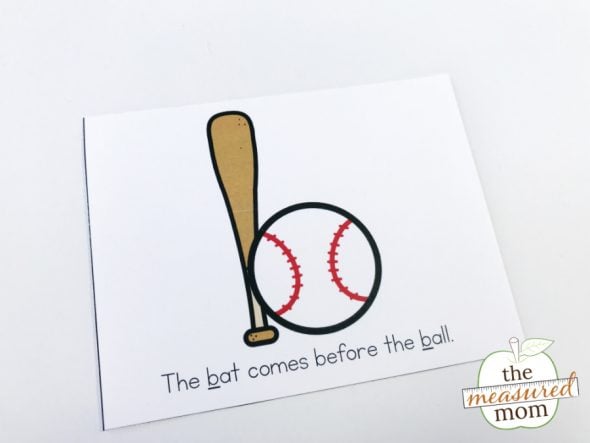
7 – With letter b, the bat comes before the ball.
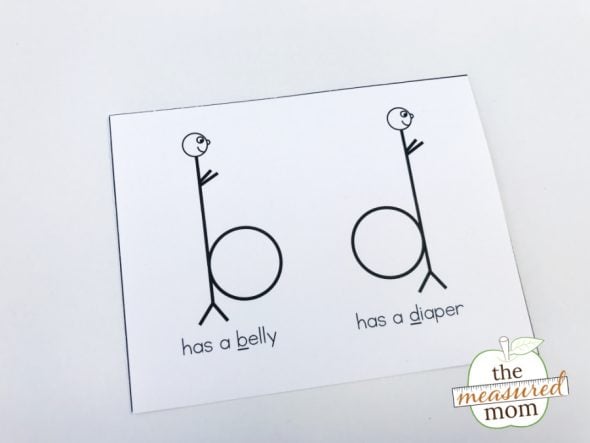
8 – The letter b has a belly. Letter d has a diaper!
I hope that one of these does the trick for your learners! Grab the free posters below.
YOU’LL LOVE THIS PRACTICAL BOOK!
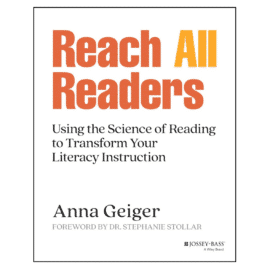
Looking for an easy-to-read guide to help you reach all readers? If you teach kindergarten through third grade, this is the book for you. Get practical ideas and lesson plan templates that you can implement tomorrow!



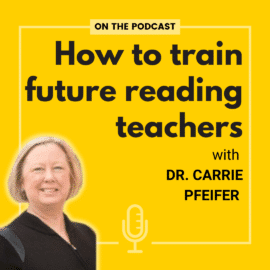
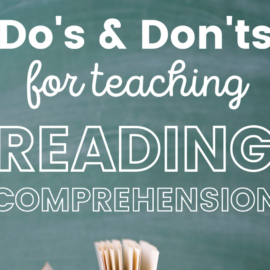
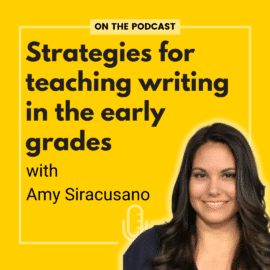
nunu
I taught him to form his thumb and index finger into a circle and raise the other fingers up and hold them close together and remember that mommy wears glasses and has “bad” eyes.
Kristine Rowe
I like to teach students songs to remember b/d. To the tune of Frere Jacques: Bat and baseball, bat and baseball, make a B, make a B! Bat and baseball, bat and baseball, make a B. Make a B. Drum and drumstick, drum and drumstick, make a D, make a D…etc. Then I draw the picture as we’re singing. I often hear students humming the tune as they’re printing. So cute!
Anna Geiger
I LOVE this, Kristine! I thought I’d heard all the ways to help with b/d reversals, but this is a new one for me!
Maim
I am thankful for these ways. I can use them in my research sample as well as to my pupils in Oman.
Heather Groth, Customer Support
We’re glad they will work well for you, Maim!
Marie Malkiewicz
Hi! I’ve been an educator (elementary and special ed) for over three decades and a reading specialist for over two. I truly appreciate all that you share and recommend your site to other professionals. I am a big fan of the “b-d-p-q chart” as I refer to it…(b for bat, d for doughnut, p for pencil and q for quarter). However, I wonder if you’ve encountered the issue of ‘d’ and ‘t’ confusion? I have a third grade learning disabled student who seems to visually confuse the two letters and I’m not quite sure how to remedy it. (He has had some visual therapy and we utilize all kinds of tracking devices to help him.) We have “looked for the doughnuts” to identify the letter d’s and highlight them. This has been somewhat effective. I recognize that the ‘d’ and ‘t’ are formed in the same part of the mouth, with one being a softer sound and the other, harder. He is able to effectively produce both sounds and we’ve worked to keep him from overproducing the sounds. I’m just not sure how else to approach this with him. The student will most often confuse the two letters when in the final position of words. (For example, he might say “sat” for “sad”.) Any recommendations for me? Thanks for all you do!
Anna Geiger
Hi Marie!
Sorry for the time it took to reply – we enjoyed some time away during Christmas break. I agree that d and t may be more easily confused because of the way both letters’ sounds are formed. Have you tried doing some isolated word work using fluency grids? You could put a bunch of words repeated on the grid, some ending with “d” and some with “t,” to improve fluency and automaticity with these endings. I have a feeling you’ve been trying most of the tricks I’d suggest!
Marie
Hi Anna,
Thanks for taking the time to respond and for the suggestion!
Lisa
Anna
Your “start with a C, to make a d” poster did the trick for my students. I would say to them every time they wrote a d, “make a c to make a d” and eventually they used that script to make their letters correctly. Thanks.
Heather Groth, Customer Support
That is wonderful to hear, Lisa! Thank you for sharing!
Starr
My 5th grader is still reversing b and d in writing and reading. Is this a major concern? What steps should I take?
Anna Geiger
Hi Starr!
As a parent, this would concern me, but it would also depend on what other challenges your child is having to know how much of a concern this would be. If your child is in school, I would talk with his/her teacher. If you are homeschooling, I would check out this blog post and ask the author what she would recommend for next steps, since she has homeschooled a large number of children with dyslexia. Best wishes to you! You can do this! https://homeschoolingwithdyslexia.com/dyslexia-signs-dyslexia/
Melanie
This child should also be screened for a vision problem and may need vision therapy vs. being dyslexic! The eyes see everything upside down and backwards, it is your brain that flips the image that you see, to be correct. If the nerves are using the wrong pathways from the eyes to the brain then they may need vision therapy.
Gina Ashe
I am in my 70s and have just looked this up as I just sent a message to my friend named Adele and realised I called her Abele. I always suspected it was because I am left handed. Ever since my school days I have alway thought of the word “bed”. (Always had untidy writing at school )
Georgia
Thank you so much! I will use the bed idea with a student who struggles with b/d. Thank you for helping kids learn English and boost their confidence!!! 🙂
Chad
Thanks alot, I am going to try the c becomes a d and the b fits in the capital B.
I have been trying the bat comes before the ball and the ball hits the door which worked, but after a couple of days my daighter goes back to mixing them up
DeAnne Robertson
I am a trained Orton Gillingham reading tutor and I’m always looking for helpful ways
for my students to distinguish between the b and d. Thank you for these great ideas!
Lyn D
Trying to help my granddaughter with this confusion. I used b is busting forward and.d is digging backwards. It helped at first but then she even gets that confused. I like the belly and the diaper.
Christine New York
I LOVED the “belly” and “diaper” idea for differentiating lowercase b and d! you’re a genius!
Ruby Zhang
It’s such a great idea to help kids learn letters. Thank you so much.
S.Gomathi
I like your all of your post very much. They are very useful to make my children understand the phonetics as well as some of the trick to make them classify the difference between d and b. thanks a lot .
Jane
Wonderful ideas, I use some of them and now I try others. Thanks a lot??
Shamirah Cabbagestalk
I love this idea, thank you so much:-)
Fath
Thanks a lot. Very useful tips. My son always have this problem… also j and t… thanks God
Perez
Great article . i cant wait to teach this technique to my 3rd grade students.
Cassie
Love the ideas! I learned it this way: the Bb’s walk (both are going the same way) and the Dd’s talk (they face each other). Thank you for sharing!
abigail
Hi Anna,
I have gone through many websites and blogs in my 20 years experience. I’ve used many among the kindergarten kids that I work with and with my coworkers. But this is the first time I am replying to someone and that someone is you. You are doing a great job and your knowledge will always grow as you keep giving to others. You are truly a blessing.
Anna G
This made my day, Abigail! Thank you SO much for this generous, kind comment! :))
NIRVA Vernet
Thank you so much for these valuable strategies.I teach English Learners making more difficult for them to recognize and remember the b and d. I have a poster of the b and d in my classroom. But, these strategies are useful teaching tools. Thank you!
Anna G
You’re welcome! 🙂
Eireen
I love it! Can’t wait to try these amazing tricks with my K1s. Showing kids how to make a bed with their hands seems to be a brilliant and fun idea! The broomstick and donut looks super exciting as well.
Amy
THANK YOU (once again)!! I like the broomstick (even better than a bat) and the “see the d” mnemonic and visual. That’s a new one, and I will be using it! XXXOOO
crystal
another poster I have seen has an upper and lower case b and it said the B’s like to walk. the other poster had an upper and lower case d and it said the D’s like to talk.
Anna G
Thanks for that idea, Crystal!
Bethany Salomon
These a such cute ways to help a child remember the name of the letters!!! I’ve had a lot of success with the “b” has a belly and a “d” had a diaper. Do you have posters for the p and q too? Your site is just terrific and I look forward to your updates!!! Thank you !!! Bethany
Anna G
I don’t, but you can find some at This Reading Mama: https://thisreadingmama.com/letter-reversal-posters/
Jen
Great ideas. I use the belly/diaper one and kindergarteners love it. We use “magic c” to make the d but also for o, a… Same hand motion to train their brain.
Anna G
Thanks for sharing that, Jen!
Chinomso
I’m in love with this! We are teaching reading and b and d confusion comes up often. I will definitely be using b lives in B (using transparencies or a sheet protector and a colored piece of cardstock), belly vs diaper (I know they will chuckle at this), AND the bed example. Such a relief. Cannot wait to showcase this on Monday morning.
Anna G
I’m glad this came at a good time for you, Chinomso! 🙂
Emily
Awesome Ideas! Thank you so much. i am really enjoying that suggestion
Gerri
Thank you for all the ideas on the b and d. My student confuse these two letters all the time. Now I know they will get c the d. LOVE,LOVE,LOVE that suggestion!
Anna G
So glad this was helpful, Gerri!
Charnelle
Hi thanks so much love it even my 3 grader turning 9 still struggle with bd
Anna G
You’re very welcome, Charnelle!
Amira
Thank You , I like the idea of starting with C
Anna G
You’re welcome, Amira!
Erin
Great ideas! I teach my kids that the curves on the upper and lowercase letter Bb are “both” on the same side of the vertical line. For the upper and lowercase letter Dd, the curves are on “different” sides of the vertical line. Since most kids learn the uppercase letters first I find this is an easier way for them to make the lowercase letters correctly.
Anna G
Thanks for another idea, Erin!
Lalitha
Great and good idea to teach the children will try an implement
Lalitha sundaram
Anna G
Thank you, Lalitha!
Stefanie Williams
I love the belly and diaper idea. I know my first graders would get a kick out of that idea and help make remembering the letter formation so much fun….and with lots of giggles, too!!
Csly
Only if you accidentally get the people facing the wrong direction they will get the letters wrong
nunu
yeah, I didn’t really understand how this one would help.
Sandra
Great ideas! Thanks so much for the help! This is an ongoing concern and discussion.
Anna G
You’re welcome, Sandra!